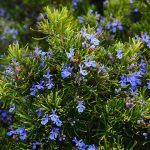In the ‘Life Of Pi’ the hero comes across an island which ends up killing fish which enter it via a sinkhole. Although this sounds far fetched, there are plants which appear perfectly capable of killing fish if their sap leaches into the surrounding water. One such tree, a small shrubby mangrove called Excoecaria agallocha L. from the Euphorbiaceae family is said to do just that. In fact, its common names refer to the fact that it causes temporary blindness and is poisonous. We have Thillai, River Poison Tree, Blind-Your-Eye Mangrove or the ‘safer’ alternative Milky Mangrove. Some refer to it as the Chinese Mangrove The latin name for the genus too means ‘blinder’.
This mangrove itself lives in the tropical swamps around the Indian, Australian and some parts of the African coastline. It is not as tolerant of saltwater as other mangrove species so lives at higher elevations. It is also widely distributed along South China’s coastlines from temperate Zhejiang to tropical Guangxi including Hainan Island.
It grows about 16 metres high. The plant is one of 40 in the genus which are still being widely investigated.
Toxicity
The milky latex is perhaps the most interesting feature of the plant which contains a range of diterpenes, triterpenoids and flavonoids (Zou et al., 2006). Like many plants in the Euphorbia family, this latex is highly corrosive if not poisonous. The latex itself causes blistering and an extreme rash on contact with the skin. The wood should not be burned as the smoke is toxic and causes blindness.
The leaves are usually dried and powdered to produce a poison for killing fish and as a dart poison and was reportedly used as such in Sarawak (Kawashima et al., 1971), New Caledonia (Ohigashi et al., 1974) and in India, Goa especially (Prakash et al., 1983). Whilst there are a number of monoterpenes present, the most interesting componentry resides in the diterpenes and triterpenoids which have all yet to be fully characterised. It seems that growing location influences the types of chemical actives produced although it probably reflects the presence of a number of sub-species given its wide dispersion. The diterpenes include the labdanes, atisanes, kauranes, isopimaranes, beyeranes, daphnanes and tiglianes.
The Chinese varieties contain predominanelty the atisane and isopimarane types (Li et al., 2007; Wang et al., 2009) whilst ones specific to Guangxi produce exogallochaols amongst those cited above (Wang et al., 2004; 2006; 2006; 2007)
There are also some tannins and flavonoids to be examined. Much of the recent evidence has been reviewed by Yin et al., (2008).
There is also some evidence for the chemical componentry in the latex being used to treat certain cancerous tissues in various cell lines (Konoshima et al., 2001). More interestingly is the anti-HIV activity as well as some activity from an antioxidant perspective. In folk medicine, the latex has been used as a purgative and abortifacient, for the treatment of ulcers, rheumatism, leprosy and paralysis in Pakistan. In Thailand, the latex is used to alleviate chronic flatulence (Wiriyachitra et al., 1985).
One study examined the inhibition of TNF-α by a variety of ent-kaurane diterpenoids called agallochaols K-P, an atisane-type diterpenoid called agallochaol Q (Li et al., 2010).
References
Kawashima, T., Takahashi, T., Inoue, Y., Kodama, M. Ito, S. (1971) Phytochemistry, 10, 3308
Konoshima,T, Konishi, T., Takasaki, M., Yamazoe, K. and Tokuda. H. (2001) Anti-tumor-promoting activity of the diterpene from Excoecaria agallocha. II Biological and Pharmaceutical Bulletin 24 pp. 1440-1442.
Li, X., Lei, J., Zheng, Y., Isabel, S., Lin, W., (2007) New entisopimarane diterpene from mangrove Excoecaria agallocha L.. Chem. Res. Chin. Uni. 23, pp. 541–543.
Li, Y., Liu, J., Yu, S., Proksch, P., Gu, J., & Lin, W. (2010). TNF-α inhibitory diterpenoids from the Chinese mangrove plant Excoecaria agallocha L. Phytochemistry, 71(17), pp. 2124-2131.
Ohigashi, H., Katsumata, H., Kawazu, K. Koshimizu, K. Mitsui, T. (1974) Agric. Biol. Chem., 38, pp. 1093
Prakash, S., Khan, M.A., Khan, H. (1983) Phytochemistry, 22, pp. 1836 .
Wang, J., Xiang, W., Guo, Y., (2005) Secoatisane- and isopimarane-tpye diterpenoids from the Chinese mangrove Excoecaria agallocha L.. Helv. Chim. Acta 88, pp. 979–985.
Wang, J., Li, Z., Xiang, W., Guo, Y., (2006) Further new secoatisane diterpenoids from the Chinese mangrove Excoecaria agallocha L.. Helv. Chim. Acta 89, pp. 1367–1372.
Wang, J., Zhang, W., Li, Z., Xiang, W., Guo, Y., Krohn, K. (2007). Elucidation of excogallochaols A–D, four unusual diterpenoids from the Chinese mangrove Excoecaria agallocha. Phytochemistry 68, pp. 2426–2431.
Wang, J., Wu, S., Li, M., Chen, S., Telling, J.L., Perry, V.H., Gu, J. (2008). Retinoic acidinducible gene-I mediates late phase induction of TNF-a by lipopolysaccharide. J. Immunol. 180, pp. 8011–8019.
Wang, Z., Lin, Y., Feng, D., Ke, C., Lin, P., Yan, C., Chen, J. (2009). A new atisane-type diterpene from the bark of the mangrove plant Excoecaria agallocha. Molecules 14, pp. 414–422.
Wiriyachitra, P., Hajiwangoh, H., Boonton, P., Adolf, W., Opferkuch, H.J., Hecker, E., (1985) Investigations of medicinal plants of Euphorbiaceae and thymelaeaceae occurring and used in Thailand; II. Cryptic irritants of the diterpene ester type from three Excoecaria species. Planta Med. 51, pp. 368–371.
Yin, B.-W., Shen, L.-R., Zhang, M.-L., Zhao, L., Wang, Y.-L., Huo, C.-H. and Shi, Q.-W. (2008), Chemical Constituents of Plants from the Genus Excoecaria. Chemistry & Biodiversity, 5: 2356–2371. doi: 10.1002/cbdv.200890201
Zou, J.H., Dai, J., Chen, X., and Yuan, J.Q. (2006). Pentacyclic triterpenoids from leaves of Excoecaria agallocha. Chem. Pharm. Bull. (Tokyo) 54 pp. 920-921.


Leave a Reply